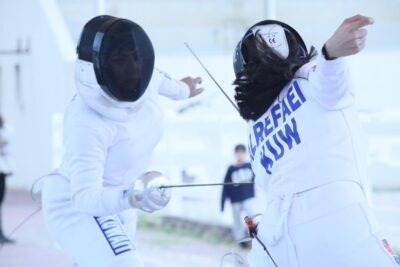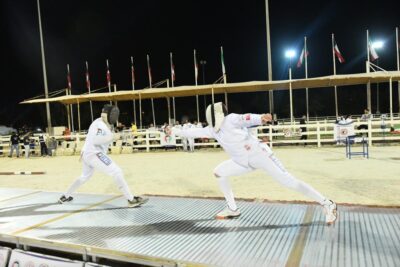FENCEING
Players compete with each other in several one-point rounds, and points are awarded according to the percentage of matches won.
Rules
- An electronic scoring device is used in competition to mark a hit that can be made anywhere on the body including clothing and equipment.
- Fencing is conducted within the piste – a long narrow area marked for play (1.5 to 2m wide x 14m long). Fencers must not go beyond this area with both feet.
- No one is to approach the piste area and disturb the bout. This includes cheering, instructing, or criticizing of referee.
- Instructions will be given en garde (on guard), allez (play), halt (stop).
- It is forbidden to turn one’s back on one’s opponent during a bout.
- Use of the non-sword hand and arm (to carry out an offensive or defensive action is forbidden).
Bonus Round
The ultimate part of the fencing competition is the Bonus Round, based on the results of the Fencing Ranking Round. The points achieved by the pentathletes in the Ranking Round are carried over to the Bonus Round.
Skills
Agility Tactical Fitness
Equipment
Specialized equipment needed includes FIE approved mesh mask, protective clothing, bodywire to attach to scoring machine and either French or pistol style epée grip.
Scoring
- 70% bouts won corresponds to 250 points.
- Each bonus round victory corresponds to 2 points.
- Each victory over or under this number is in accordance with the number of the bouts as laid down by the points table for the fencing event of the modern pentathlon. The points table can be found in the fencing rules section of the UIPM website.
Fencing is a combat sport that involves two competitors facing off against each other with weapons known as foils, épées, or sabers. This sport combines elements of strategy, precision, and athleticism to score points by striking an opponent while adhering to a set of rules and regulations.
Fencing has a rich history dating back to ancient times when it was initially developed as a form of combat training for dueling and self-defence. Over the centuries, it evolved into a sport with standardized rules and specialized equipment. In fencing, competitors aim to score points by making valid hits on their opponent’s target area using the designated weapon. The scoring is highly technical and relies on electronic scoring systems that register hits with the required amount of force. A valid hit results in a point being awarded to the fencer who made the hit. Fencing is governed by a strict set of rules and regulations established by international organizations such as the Fédération Internationale d’Escrime (FIE). These rules govern everything from the size of the fencing piste (the playing area) to the timing of the bouts and the conduct of the fencers. Fencers wear protective gear, including masks, gloves, jackets, and pants, to minimize the risk of injury. The mask has a metal mesh to protect the face, while the rest of the clothing is designed to prevent injuries from punctures or cuts. Fencing is not just about physical agility but also mental strategy. Fencers must anticipate their opponent’s moves, feint, parry attacks, and counter-attack effectively to score points. It’s often described as physical chess due to its strategic nature. Fencing competitions range from local tournaments to international events, including the Olympics. Fencers are divided into various categories based on age and skill level. These competitions can be individual or team-based. Fencing offers numerous benefits, including improved physical fitness, enhanced mental agility, discipline, and sportsmanship. It’s also a unique and exciting way to stay active and engage in a rich and historical sport. In summary, fencing is a dynamic and highly skilled combat sport that combines athleticism, strategy, and precision. It has a long and storied history and continues to be a popular and respected sport worldwide.








